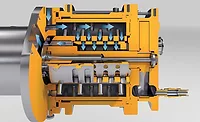Is the Milling Stage Killing Your Operational and Financial Performance?
Area: Operational Performance Improvement

Milling is a key stage in the paints and coatings production process. Paints and coatings companies quite often place more emphasis on getting the product out to customers, inadvertently putting pressure on the process. If certain parallel and targeted improvement initiatives are taken, efficiency in the milling stage can be significantly improved, with a positive impact on operational and financial performance.
Problems/Issues
High milling cycle times, delivery issues, frequent mill tripping, frequent mill breakdowns, low mill utilization, process delays, inconsistency in working practices, rejected batches due to quality and process issues, etc. are some of the main issues that arise during the milling stage.
Do these issues sound familiar concerning your coatings production facilities? These are just the tip of the iceberg. These issues are technical and operational, but ultimately impact a company’s financial performance. If not addressed effectively, the consequences could be a negative impact on the profitability, high production costs (manpower, energy, mills, materials etc.), customer delivery issues, customer complaints, customer claims, scrap inventory, disposal costs, negative impact on employee morale, frustration, and so on.
Of all the stages in paints and coatings production, milling is the main process stage that consumes most of the manpower, materials, energy, maintenance and resources. The performance of the milling stage drastically impacts the operational and financial performance of a company.
No matter how good a paint formation could be, it all comes down to the proper execution of the activities in a standardized and consistent manner in the milling stage. If there are inadequacies concerning personnel handling of specific tasks, process or equipment capabilities in this stage, quite often the company takes the bait of unseen financial losses, which may be hard to quantify. Depending on the current state/performance of the milling stage, if the inadequacies are rightly addressed and removed, significant internal cost savings can be achieved.
Quite often companies focus on one or two problem areas at a time and are sometimes unaware of the fact that, when all areas are rightly done and executed as per the standards, then only an overall higher efficiency in the milling stage can be achieved. Every step in a milling stage defines the performance of the succeeding step, and this extends/impacts the performance of further stages in the paint production.
A holistic assessment of the entire spectrum of tasks carried out in the milling stage combined with targeting individual problem areas will lead to enhanced performance and significant improvements in the milling stage. Sometimes technical knowledge as simple as having an awareness of the science and logic behind why a certain task is carried out in the milling stage could be missing.
Assessment Areas
Several areas within the milling stage can be assessed to make area-specific improvements. Those areas include, but are not restricted to:
- Fineness measurement: Standards, training, consistency, equipment;
- Pre-stirring: When to pre-stir, duration, training, SOP;
- Premixing: Selection of equipment, mixing parts, dimensions, material sequencing, SOP;
- Mill external setup: Cooling water flow rates, declogging, right flow meters;
- Mill internal setup: Cooling water flow rates, beads, disks, dimensions, positioning;
- Milling parameters: Process parameters, dynamics, product type, standardization, training;
- Mill maintenance: Inspections, replacements, scheduling;
- Mill allocation to products: Product-mill allocation based on product type and mill features;
- Product formulation, mill type selection, etc.
Improvement Areas
Massive improvements can be achieved throughout the entire spectrum of the milling stage, including:
- Improvement in overall milling cycle time and process;
- Better running of the mills at optimal performance;
- Reduction in mill breakdowns and maintenance costs;
- Better fineness measurement, pre‑stirring, premixing;
- Better understanding of the science and logic behind premixing, pre-stirring and milling;
- Better adherence to the standard procedures;
- Increase in the morale of the employees;
- Better controls to sustain the improvements.
Broader positive impact on the company performance may include but is not restricted to:
- Positive impact on the profitability due to reduction in manufacturing costs;
- Improvement in delivery times;
- Reduction in scrap inventory, etc.
Conclusion
The milling stage is the heart of paints and coatings production. Anomalies in the process, equipment or personnel executing the tasks in this stage will prove costly to ignore, as over time they will have a drastic negative impact on the financial and operational performance of a company.
It is recommended that companies with their internal experts and/or through external support, assess the entire spectrum of their milling stage and identify areas for improvement to improve overall performance. With the inclusion of operational excellence and lean six sigma principles, the improvements can be sustained and the learnings can be widely extended to other facilities in your organization.
For more information, e-mail venkat@jevvrs.com or visit www.jevvrs.com.
Looking for a reprint of this article?
From high-res PDFs to custom plaques, order your copy today!






